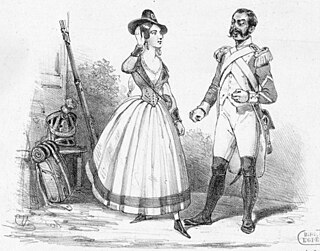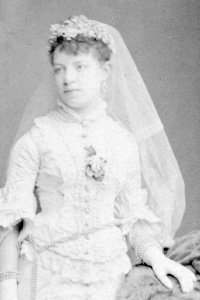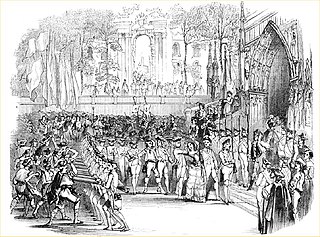
Maria Anna MarziaAlboni was a renowned Italian contralto opera singer. She is considered "one of the greatest contraltos in operatic history".

La fille du régiment is an opéra comique in two acts by Gaetano Donizetti, set to a French libretto by Jules-Henri Vernoy de Saint-Georges and Jean-François Bayard. It was first performed on 11 February 1840 by the Paris Opéra-Comique at the Salle de la Bourse.

Michael William Balfe was an Irish composer, best remembered for his operas, especially The Bohemian Girl.

William Vincent Wallace was an Irish composer and pianist. In his day, he was famous on three continents as a double virtuoso on violin and piano. Nowadays, he is mainly remembered as an opera composer of note, with key works such as Maritana (1845) and Lurline (1847/60), but he also wrote a large amount of piano music that was much in vogue in the 19th century. His more modest output of songs and ballads, equally wide-ranging in style and difficulty, was also popular in his day, some numbers being associated with famous singers of the time.
"Clay" is a short story by James Joyce published in his 1914 collection Dubliners. It deals with the reflections of a middle-aged, unmarried woman during the course of her day.

The Bohemian Girl is a 1936 comedic feature film version of the opera The Bohemian Girl by Michael William Balfe. Directed by James W. Horne and Charles Rogers, and it was produced at the Hal Roach Studios, and stars Laurel and Hardy, and Thelma Todd in her final film role. This was also the only appearance of Darla Hood in a full-length feature produced by Hal Roach.

La zingara is an opera semiseria in two acts by Gaetano Donizetti, set to a libretto by Andrea Leone Tottola after La petite bohémienne by Louis-Charles Caigniez, which was itself derived from a work of August von Kotzebue.

The Maid of Artois is an opera by Michael William Balfe, written in 1836 to a libretto by Alfred Bunn, manager of the Theatre Royal, Drury Lane, in London, who based his work on Eugène Scribe's stage version of Abbé Prévost's novel Manon Lescaut.

Mirette is an opéra comique in three acts composed by André Messager, first produced at the Savoy Theatre, London, on 3 July 1894.

Giulia Warwick was an English opera and concert singer and professor of music in the last quarter of the 19th century. She is best known for roles with Richard D'Oyly Carte's Comedy Opera Company and with the Carl Rosa Opera Company.
Gypsy Girl or The Gypsy Girl may refer to:
"I Dreamt I Dwelt in Marble Halls", or "The Gipsy Girl's Dream", is a popular aria from The Bohemian Girl, an 1843 opera by Michael William Balfe, with lyrics by Alfred Bunn. It is sung in the opera by the character Arline, who is in love with Thaddeus, a Polish nobleman and political exile.

The Merry Zingara; Or, The Tipsy Gipsy & The Pipsy Wipsy was the third of W. S. Gilbert's five burlesques of opera. Described by the author as "A Whimsical Parody on The Bohemian Girl", by Michael Balfe, it was produced at the Royalty Theatre, London, on 21 March 1868.

The Bohemian Girl is a 1922 British romance film directed by Harley Knoles and starring Gladys Cooper, Ivor Novello, and C. Aubrey Smith. It was inspired by the opera The Bohemian Girl by Michael William Balfe and Alfred Bunn, which was in turn based on a novel La Gitanilla by Miguel de Cervantes. Originally released at 70 minutes, the surviving print is missing the first two reels and small portion of the last, timing at 46 minutes.

Ann(e) Childe Seguin (1811–1888) was a British and American opera singer who was part of the Seguin Troupe in America. Her best known role was as the lead in The Bohemian Girl.

William Felix Knight, was an American tenor, actor, and vocal teacher, best known for his role as Tom-Tom in the 1934 Laurel and Hardy holiday musical film Babes in Toyland.

The Bohemian G-yurl and the Unapproachable Pole is a musical burlesque in two acts, with a score by Meyer Lutz to a libretto by Henry James Byron, which played under the management of John Hollingshead at the Gaiety Theatre in London in 1877. It was a parody of the popular opera The Bohemian Girl composed by Michael William Balfe with a libretto by Alfred Bunn.

Alice, Where Art Thou? is a popular British parlour song of the Victorian era. It was composed by Joseph Ascher. The text was by Wellington Guernsey, although it is sometimes attributed to Alfred Bunn, who is best known for "I Dreamt I Dwelt in Marble Halls". It become a popular song, selling many copies of sheet music and featuring regularly as a standard in the music halls.
















